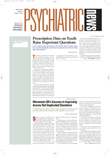In many respects, the advances in research in psychiatry during the last quarter of the 20th century are among the greatest triumphs of our profession. It amazes me to think of the disorders for which we now have specific, effective treatments but were essentially untreatable when I was a resident 25 years ago. If the progress is to continue, we have some challenges to overcome, and, as is true so often in psychiatry today, many of those challenges have to do with money.
Before we turn to the obstacles that we must overcome to continue our progress, consider how far we have come. At the conclusion of the Decade of the Brain—as the National Institute of Mental Health (NIMH) designated the 1990s—we had developed an array of technologies, such as functional magnetic resonance imaging (fMRI) and positron emission tomography (PET), that allowed us to peer into the living brain as we have never been able to do before. Apart from the scientific progress embodied in the findings of these new functional imaging techniques, they constitute powerful means of persuading the public and key decision makers about the reality of mental illness and its effects on the brain. And as we begin to assess the impact of treatment on brain function, the resulting images will constitute graphic depictions of the efficacy of our techniques.
In the next decade, we reasonably expect that the genomic revolution will enable us to track the pathogenic processes in many psychiatric disorders to their roots in molecular abnormalities caused by genetic variations. Though progress in psychopharmacology has often been reliant on serendipity—recall the stories of the discovery of the effects of the monoamine oxidase inhibitors, lithium, and chlorpromazine—that need not be the case in the future. We are likely to see the development of interventions targeted at pathogenic variation in protein structure and DNA that will allow better treatment, with fewer side effects, than ever before. And we may perhaps witness the first genuine preventive interventions that our field has known.
At the same time, our technologies for epidemiologic, cognitive, and social science research, along with the statistical pillars on which they rest, have also advanced markedly. We understand more about the prevalence and distribution of psychiatric illness, and about the impact of at least some environmental variables, than we ever have before. And our interventions are by no means limited to psychopharmacologic treatment: the evidence base supporting psychotherapeutic and other psychosocial interventions grows apace.
Unfortunately, the picture is not without its dark spots and premonitions of further problems to come. Although psychiatric research is flourishing, by and large it is not being done by psychiatrists. The percentage of research grants in mental health that go to psychiatrists is the lowest it has been in decades. Established researchers are finding it hard to recruit residents into research careers. The high debt burdens that many residents carry—averaging $95,000 in 2000 and often much greater—is undoubtedly part of the reason they elect to forego research fellowships for the greater immediate rewards of clinical practice. A typical stipend for a federally supported research fellowship is $38,628 a year.
Another factor is the uncertainty regarding funding for a research career. Times have been good over the last five years, but what comes next? For many young would-be investigators, staking their careers on the uncertainties of the next R01 application seems too great a risk. Thus, M.D. postdoctoral trainees supported by NIMH have decreased by 50 percent since 1992, from 342 to 210. Where will the money come from to support those careers?
Research, for most academic departments, is not a money-making enterprise. To the contrary, it typically takes dollars from department budgets to support the research effort. Since the growth of medical research in the United States in the years following World War II, with the creation of the National Institutes of Health (NIH), academic departments subsidized their researchers—particularly those early in their careers—with dollars generated from clinical endeavors. But with clinical work no longer covering its costs or breaking even at best in many places, the surpluses that once enabled young faculty to get on their feet, more established faculty to be carried through lean periods, infrastructure to be built, and pilot studies to be conducted no longer exist.
Faculty members, who once were expected to do clinical studies, write papers, and generate grant proposals during the work week, along with taking care of their clinical responsibilities, are now so stressed merely by the need to meet their quotas of patients, revenues, and RVUs that they have no time left to foster their research careers. Without relief from these pressures, medical research—but because of the greater financial stresses that we confront, psychiatric research in particular—faces a future much less bright than it might have been.
How do we reverse these pressures that have squeezed American academic medicine—the envy of the medical world—to the point where the viability of many academic research centers is endangered? Part of the answer, of course, is to infuse back into the psychiatric treatment system the resources that have been systematically stripped from it over the last 15 years. The reductions in payments and increases in costs caused by managed care and government cutbacks have not only created a crisis in access for patients, but also threatened the research (and education, another topic worth separate consideration) enterprise on which the future of psychiatry and all of medicine depends. Payers, whether governmental or private, must recognize the necessity of paying rates that not only cover the direct costs of care, but also support the infrastructure on which viable treatment, research, and training enterprises all rest.
Direct support of research is another piece of the answer. Over the last five years, Congress has nearly carried out a commitment to double the NIH budget. At this writing, we await congressional action on the last installment of that promise, embodied in the Fiscal 2003 appropriation. It is important for the future of American medicine that this commitment be fulfilled. However, we are now told that the Bush administration plans to recommend that next year’s budget not even cover the costs of inflation—representing a real decrease in the dollars available for research support. Such an outcome would be tragic.
Young people looking to careers in psychiatric and other medical research need to know that the dollars to support their investigations will be there next year and the years after that. Allowing the tap to run full and then go dry does nothing but convince researchers early in their careers of the looming insecurity of a research position. It dissuades departments and medical schools from investing in research facilities. It slows the pace of knowledge acquisition and application. Boom and bust is no happier a scenario in the laboratory or clinical research unit than it is on Wall Street.
APA has been working with a coalition of groups to encourage Congress to complete the process of doubling the NIH budget. You can help by going to the APA Web site at
http://congress.nw.dc.us/psych/home/ and sending a message on this subject to your representatives in Congress, using the automated e-mail software accessible at this site. (Another way to access this feature is to go to www.psych.org/pub_pol_adv/index.cfm and click on “Advocacy Action Center.”) APA is also preparing for the next stage of the fight: convincing the Bush administration and Congress of the importance of sustained support for research. Anyone who sees patients knows that we have a long way to go. ▪

